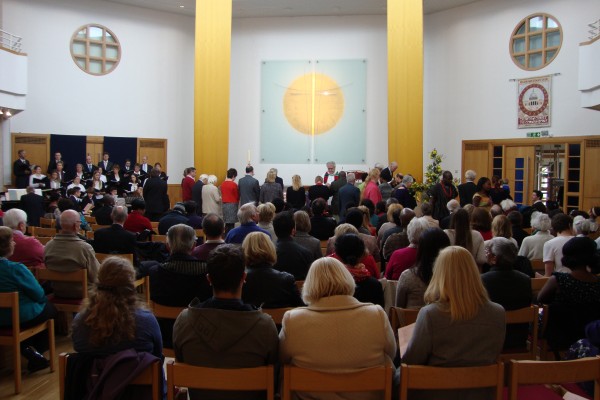Music to End the Day Sunday, 11 April 2021
Hello, everyone.
Our music this evening continues to celebrate the joy of the Resurrection!
We begin with a short improvisation that I created at home
just before Easter on the ancient French carol melody ‘Noel Nouvelet’.
In France the tune is well-known as a popular Christmas carol,
but in England we more often associate it with John Crum’s
early twentieth century Easter text ‘Now the green blade riseth’.
Crum was chaplain to the Bishop of Oxford
and later a canon of Canterbury Cathedral.
The hymn was first published in the Oxford Book of Carols 1928.
Its vivid imagery is biblically based:
‘Verily I say unto you, except a corn of wheat fall into the ground and die, it abideth alone: but if it die, it bringeth forth much fruit.’
John 12: 23–24
Throughout the hymn, Crum uses ‘Love’ as a vivid metaphor for the Risen Christ. In the last verse he emphasises that no matter what we are going through, ‘Jesus’ touch can call us back to life again’.
Now the green blade riseth from the buried grain,
wheat that in dark earth many days has lain;
love lives again, that with the dead has been:
Love is come again, like wheat that springeth green.
In the grave they laid him, Love whom men had slain,
thinking that never he would wake again,
laid in the earth like grain that sleeps unseen:
Love is come again, like wheat that springeth green.
Forth he came at Easter, like the risen grain,
he that for three days in the grave had lain,
quick from the dead my risen Lord is seen:
Love is come again, like wheat that springeth green.
When our hearts are wintry, grieving, or in pain,
thy touch can call us back to life again,
fields of our hearts that dead and bare have been:
Love is come again, like wheat that springeth green.
J.M.C. Crum (1872–1958)
CCL31580
In Part 3 of ‘Messiah’, Handel turns to Paul’s teachings
on the Resurrection at the Day of Judgement,
as written in I Corinthians 15: 51–53,
for his great aria, ‘The trumpet shall sound’.
This image, first found in Exodus 19, pictures a courtly herald
who blew the trumpet as a signal that the king
was about to enter the throne room,
a signal to stand in his honour.
In the preceding recitative, ‘Behold I tell you a mystery’,
motifs like trumpet signals appear in the strings
at the approach of the words ‘at the last trumpet’.
The aria itself offers a thrilling dialogue
between trumpet and bass-baritone soloists.
At ‘and we shall be changed’ the word ‘changed’
is treated to inventive ever-changing melismas up to six bars long.
The soloists in this recording are
Philip Tebb (bass-baritone) and John MacDomnic (trumpet),
with the Cornerstone Chamber Orchestra.
Behold, I tell you a mystery: we shall not all sleep,
but we shall be all changed in a moment,
in the twinkling of an eye, at the last trumpet.
The trumpet shall sound,
and the dead shall be raised incorruptible,
and we shall be changed.
For this corruptible must put on incorruption,
and this mortal must put on immortality.
We end this seasonal musical offering
with the final movement of John Rutter’s ‘Suite Antique’.
Rutter composed this work early in his career,
for a concert at which Bach’s 5th Brandenburg Concerto was to be performed,
so decided to write the piece for the same ensemble of flute, harpsichord and strings.
The final movement is entitled ‘Rondeau’ and features a lively theme in 5/8 time,
heard four times in all, separated by characterful episodes.
The solo flautists in this recording is Cornerstone’s great friend, Abigail Burrows.
To conclude, a prayer for this Easter Season:
Dear Lord,
the resurrection of your Son has given us new life and renewed hope.
Help us to live as new people in pursuit of the Christian ideal.
Grant us, wisdom to know what we must do, the will to want to do it,
the courage to undertake it, the perseverance to continue to do it,
and the strength to complete it.
Amen
Goodnight, everyone.
Adrian Boynton


